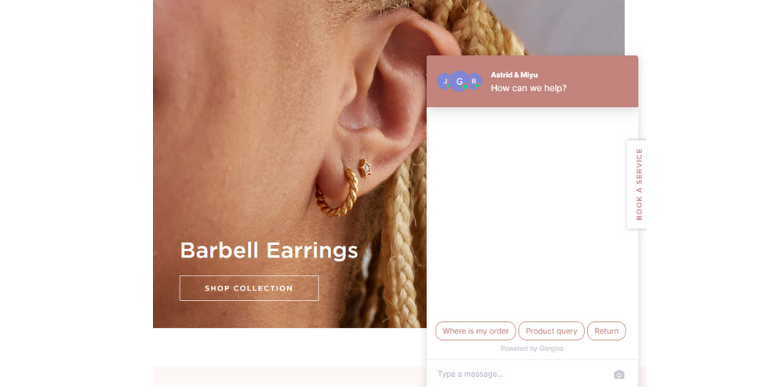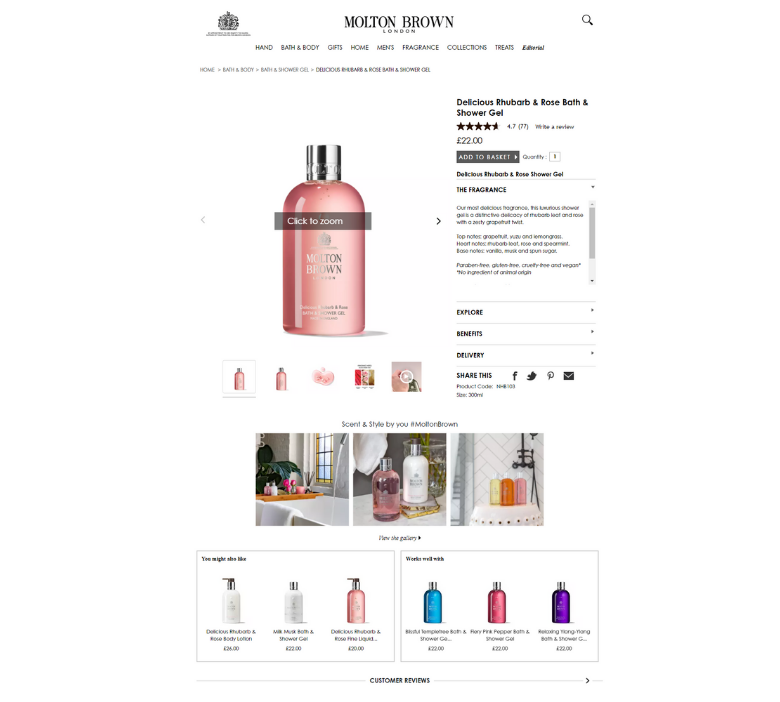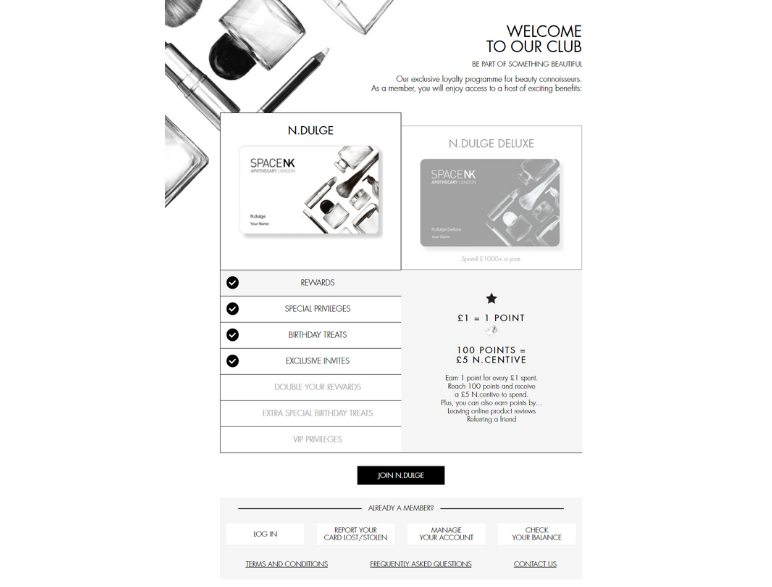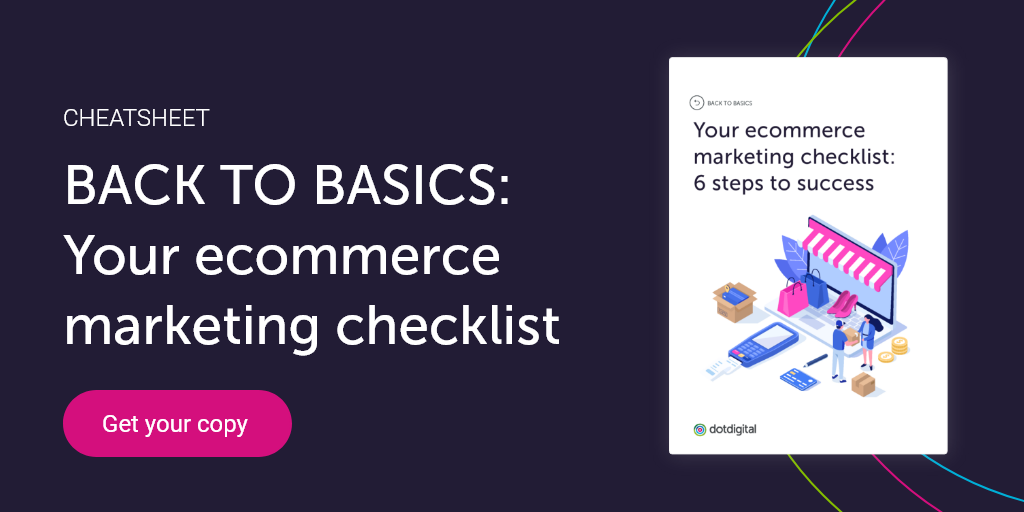What is ecommerce marketing?

Every online retail brand wants to increase traffic, conversions, and sales. With so much competition, ecommerce brands need a clear and well-defined strategy to capture and convince website visitors to become repeat customers.
In this article, we’ll outline our top tips to elevate your ecommerce marketing strategy.
What is ecommerce marketing?
Ecommerce marketing drives awareness, traffic, and actions towards brands selling goods or services online. Using promotional tactics, the goal is to convert traffic into paying repeat customers.
It’s important to remember ecommerce marketing and digital marketing do not have to be mutually exclusive. There are a wide variety of channels and strategies that can be adopted.
Types of ecommerce marketing
Ecommerce strategy generally combines email marketing, social media, digital content, and search engines to attract customers.
But this is not enough. A truly successful ecommerce marketing strategy uses online and offline marketing tactics. Modern customers demand seamless and consistent experiences with brands. Omnichannel marketing needs to be at the core of your ecommerce business to meet these growing demands.
Social media marketing
Today, most brands use social media networks to connect with their audience. The content you post needs to grab attention and engage audiences as they scroll.
Social media is a strong channel for ecommerce brands as your websites tend to be highly visual, relying on imagery to help convert visitors. Platforms like Instagram and Snapchat are perfect for posting product photography to extend your brands reach to wider audiences.
Another powerful reason for ecommerce brands to adopt social media marketing is the opportunity to create shoppable content. Not only are images engaging scrollers, but shoppable content enables them to buy immediately.
Influencer marketing
Influencer marketing uses the people and brands that influence your target audience to connect with new and existing customers. Influencers have strong communities that know, like and trust them. A simple recommendation or sponsored post can help your brand attract new attention and new sales.
Content marketing
Content marketing uses online material like videos and blogs to spark interest in products or services, without directly promoting a brand. Most content marketing aims to improve your website’s ranking in search engines.
Optimizing webpages and answering any and all questions about your products or services will help build both site authority and traffic. The more of those you have, the higher you’ll rank on the likes of Google and Bing. And, the higher you organically rank, the more successful your ecommerce store will be.
Search engine marketing
Search engine marketing (SEM) is a combination of search engine optimization (SEO) and paid advertising. SEO relies on your high-quality content to rank on search engines, while SEM also involves pay-per-click (PPC) and display ad campaigns. Paid advertising allows you to pay for the top spots on search engine result pages.
Offline marketing
Offline marketing is often neglected by ecommerce brands. In most cases 100% of sales are online so a digital-first strategy makes sense. But there is value in offline marketing. Catalogs, pop-up stores, and events present even more opportunities to connect with your audience.
Email marketing
Email marketing is almost as old as digital marketing itself. And it holds great value for ecommerce brands. When used correctly, email marketing can offer brands an ROI of $40 for every $1 spent. When fully optimized to its greatest potential, email marketing can boost your profits even further.
Another unbeatable benefit of email marketing is that it can be automated. Automation allows you to set up campaigns to run in the background while you work on your long list of marketing activities. It also enables you to create stronger connections with the help of advanced personalization capabilities.
Essential ecommerce automations

Marketing automation is an essential element of an ecommerce marketing strategy. There are several core automation programs every ecommerce brand should build.
Welcome program
The welcome program is your first opportunity to introduce your brand to a new customer. After signing up for your mailing list, they must receive a prompt welcome email. Not only does this make readers feel appreciated, but it also makes your brand look active and professional.
It’s also a great opportunity to get to know your new customer. There’s no better time to get to know your customers than at this early stage of the relationship.
Drip campaign
Drip campaigns are the perfect follow-on from your welcome program. They nurture your customers until they’re ready to make a purchase. With the data you’ve collected during your welcome program, you can segment and personalize these emails. When you send customers down specific paths that resonate with their goals it drives them to convert faster.
Abandoned cart automation
Never miss an opportunity to convert a website visitor into a paying customer with a well-timed and engaging abandoned cart email. Once an email subscriber adds an item to their shopping cart you can automate a reminder to drive them back to your site to complete their purchase.
Users abandon carts for a lot of reasons. A well-crafted and frequently tested abandoned cart program will be able to resolve the blockers to conversion.
Post-purchase campaign
Post-purchase emails are one of the best ways to keep customers engaged after they’ve converted. When you engage customers after they’ve made a purchase, they’re more likely to become loyal, repeat customers. Consider sending customers information such as care tips for their new products or advice on how to utilize your services. This will help convince shoppers that you’re a trustworthy, customer-centric brand.
Feedback and review campaign
Feedback and review requests can often form part of your post-purchase campaign but work brilliantly solo too. User-generated content is a must-have tactic in ecommerce marketing and one of the best resources for this is your review platform. Modern shoppers trust their peers’ opinions more than the promises of a brand. By collecting these opinions you’ll also be collecting an invaluable marketing resource.
Ecommerce marketing tips
There is an endless amount of ecommerce marketing tactics brands use to drive online sales. As technology advances, new tactics will emerge, but we’ve identified six unbeatable tactics you need to adopt today to drive real results.
1. Personalization
Customers don’t want to receive batch and blast marketing anymore. They want to be treated as individuals. Luckily, we’ve had the tools to do so at our fingertips for a while now, which means they’re pretty advanced at this point.
Still, personalization is a massively under-utilized marketing tactic among ecommerce brands. In fact, our Hitting the Mark report 66% of brands still aren’t using even basic personalization tactics.
Every ecommerce brand should be using personalization and segmentation tactics. This will ensure you’re delivering personal and relevant content to every customer. As your tactics advance, you’ll be able to apply dynamic content and RFM segmentation tactics to drive repeat conversions from delighted customers.

2. Customer experience
Customer experience has been a buzzword for ecommerce marketers for a while now. But it’s a staple that customers look for when deciding whether to shop – or shop again – with a brand.
Customers are looking for a brand that makes it as simple as possible to complete reach their goals. That means ecommerce brands need to remove roadblocks and resolve issues quickly to convert the reader. The solution is simpler than you think.
Live chat on your ecommerce store empowers customers to reach out when a roadblock occurs. Your customer service agents can help resolve any issues, pre- or post-purchase, and leave customers with a long-lasting, positive impression of your brand.

3. Omnichannel automation
If you needed proof that modern shoppers are a demanding bunch, look no further.
As well as wanting to have a unique and individual experience with you, and having any problems resolved, they also want a seamless, connected experience with your brand. For ecommerce marketers to achieve this, they need an omnichannel marketing strategy.
Identify key touchpoints in the customers’ journey where you can transition the conversation to a new channel. Retargeting customers who’ve become unengaged with a personalized display ad is a great way to drive lapsed shoppers back to your site. Prompting shoppers with a location-based SMS about your pop-up shop is perfect for making spontaneous sales.
4. Product recommendation
Make it as easy as possible for customers to discover the product they want and need with product recommendations. Placing product recommendations on product pages, in emails (especially abandoned cart programs), and on shopping cart pages are great for showcasing your catalog.
Product recommendations can help ecommerce brands cross-sell and upsell products. They also have the added benefit of increasing average order value (AOV), sometimes by over 300%. Personalized, AI-powered recommendations that predict items to interest the shopper, all-but guaranteeing conversions. A definite must-use tactic for an ecommerce marketing strategy.

5. User-generated content
User-generated content (UGC) is essentially influencer marketing but on a smaller scale. Reviews and feedback post-purchase can give you a priceless treasure trove of content to use in your ecommerce marketing. You can use them in social media campaigns and on product pages to drive traffic and conversions.
But also think about ways you can encourage customers to promote and share your business. The best way to do this is on social media. Running competitions is an unbeatable tactic – after all, who doesn’t love to win! Encourage your followers to tag and share your content for a chance to win and watch your traffic surge.

6. Loyalty programs
It’s not a surprise to discover that loyalty programs create loyal customers. The clue’s in the name. But during our research for Hitting the Mark, we discovered 80% of ecommerce brands didn’t have one. Loyal customers have already shopped with you so are cheaper to engage than acquiring new customers. They’ll also spend 35% more with your brand, even when they can find similar products at a cheaper price.
Imagine how much that would increase if, with every purchase, they were being rewarded. Loyalty programs should be thoughtful, delightful, and on-brand to create an emotional bond with the shopper. The stronger the connection, the quicker they’ll become loyal shoppers.

Refresh your ecommerce marketing tactics
Whether you’re looking for a refresh or at the beginning of your journey we have endless resources to help you boost your ecommerce marketing success.




